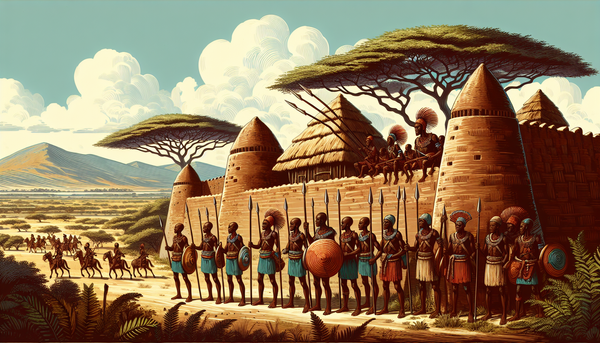Historical Sites of African Heritage: Preserving the Past for Future Generations

Introduction to Significance of African Heritage Sites
African heritage sites hold immense historical, cultural, and spiritual significance, serving as tangible reminders of the continent's rich past and diverse civilizations. From the ancient pyramids of Egypt to the rock-hewn churches of Lalibela, these landmarks illustrate the architectural ingenuity and cultural depth of Africa's people. They offer invaluable insights into historical narratives, societal structures, and traditions that have shaped both the continent and the world.
Moreover, African heritage sites are critical for promoting cultural identity and pride among local communities. They act as focal points for education, reinforcing the understanding of history among younger generations while fostering a sense of belonging. This connection to the past is vital, particularly in an era where globalization often threatens to dilute localized cultures.
Additionally, these sites contribute significantly to the economy through tourism, drawing visitors from around the globe who seek to experience Africa's history firsthand. In turn, this tourism provides resources that can help support conservation efforts. However, the challenge remains in balancing development, preservation, and community involvement to ensure that these invaluable assets are safeguarded for future generations. The preservation of African heritage sites is not only about saving structures; it’s about maintaining the spirit and stories of countless ancestral lives.
Challenges in Conservation of Cultural Landmarks
The conservation of cultural landmarks in Africa faces numerous challenges that threaten the integrity and longevity of these invaluable sites. One significant issue is insufficient funding and resources for preservation efforts. Many countries struggle with economic constraints, leading to neglect of historical sites that require ongoing maintenance and restoration. Without adequate financial support, these landmarks are increasingly at risk of deterioration.
Environmental factors also pose a serious threat to the conservation of cultural sites. Climate change, extreme weather conditions, and natural disasters can lead to irreversible damage, eroding structures and artifacts. For example, rising sea levels threaten coastal sites, while desertification affects monuments located in arid regions.
Additionally, urbanization and industrialization often place cultural landmarks in direct conflict with modern development projects, resulting in encroachment and sometimes outright destruction. This ongoing tension between heritage conservation and economic growth complicates efforts to protect these sites.
Furthermore, a lack of awareness and appreciation for cultural heritage among local populations can hinder conservation initiatives. Engaging communities and fostering a sense of ownership is crucial, but it often requires extensive education and outreach efforts, which may not be readily available. Addressing these challenges is essential for the preservation of Africa's rich cultural heritage for future generations.
Role of Local Communities in Heritage Preservation
Local communities play a pivotal role in the preservation of heritage sites, acting as guardians of cultural heritage and custodians of history. Their intimate connection to these landmarks often leads to a profound understanding of the traditions, stories, and practices that shape their significance. Engaging communities in preservation efforts fosters a sense of ownership and pride, encouraging individuals to actively participate in safeguarding their cultural legacy for future generations.
One of the key benefits of involving local populations is the wealth of traditional knowledge they possess about the construction, maintenance, and historical context of heritage sites. This knowledge can be invaluable for restoration projects, ensuring that the techniques and materials used are authentic and culturally relevant. Additionally, local communities can contribute to the monitoring of sites, helping to identify potential threats or areas in need of attention.
Furthermore, when locals are included in tourism and conservation strategies, they stand to benefit economically, creating livelihoods that rely on their heritage rather than putting it at risk. Educational programs that highlight the importance of cultural preservation can also galvanize younger generations, ensuring that traditions and sites are respected and maintained. Collaboration between local communities, governments, and organizations is essential for the sustainable preservation of Africa’s rich historical tapestry.
Impact of Tourism on Historical Sites
Tourism can have both positive and negative impacts on historical sites, making it a double-edged sword in the realm of cultural heritage preservation. On the positive side, tourism can provide crucial financial resources that support conservation efforts. Entrance fees, guided tours, and other revenue streams can be funneled back into maintenance and restoration projects, ensuring that these landmarks are preserved for future generations. Additionally, increased visibility often fosters greater appreciation for cultural heritage among locals and visitors alike, encouraging advocacy for preservation.
However, the influx of tourists can also present significant challenges. Overcrowding at popular sites can lead to physical wear and tear, with foot traffic causing erosion, pollution, and structural damage. In extreme cases, sites may become so popular that the very essence of the experience is diminished, transforming sacred spaces into mere commodities.
Furthermore, tourism can sometimes prioritize short-term profits over sustainable practices, resulting in neglect of conservation responsibilities. Local communities may become displaced or marginalized as commercial interests grow.
Balancing the benefits and drawbacks of tourism is crucial for the sustainable management of historical sites. It requires strategies that promote responsible visitation while safeguarding cultural integrity, ensuring that the rich heritage of these landmarks is preserved and celebrated.
Innovations in Archaeological Research and Restoration
Innovations in archaeological research and restoration are transforming the way historical sites are studied, preserved, and appreciated. Advanced technologies, such as LiDAR (Light Detection and Ranging), enable archaeologists to create detailed topographical maps of sites hidden beneath dense foliage or urban environments. This non-invasive technique reveals structures and landscapes previously obscured, providing valuable insights into ancient civilizations without disturbing the ground.
Additionally, 3D scanning and printing technologies are revolutionizing restoration efforts. By accurately capturing the intricate details of artifacts and structures, archaeologists can create precise replicas for educational purposes or temporary displays. This not only protects the original items from damage due to extensive handling but also allows wider access to cultural heritage.
Digital platforms and interactive technology, such as augmented reality (AR) and virtual reality (VR), are enhancing visitor experiences at historical sites. Through these innovations, individuals can engage with the past in immersive ways, fostering a deeper understanding of cultural heritage and encouraging stewardship.
Lastly, interdisciplinary collaborations, combining expertise from various fields including anthropology, engineering, and environmental science, are leading to more effective conservation strategies. By integrating innovative research methods, restoration projects can be guided by a holistic understanding of historical contexts, ensuring that these heritage sites remain vibrant and relevant for future generations.
Case Studies: Successful Preservation Efforts
Successful preservation efforts around the world showcase the potential for effective strategies in safeguarding cultural heritage. One notable case is the restoration of the Great Mosque of Djenné in Mali, a UNESCO World Heritage site. Constructed in mud brick, the mosque faced constant challenges from erosion and heavy rains. Local craftsmen utilized traditional building techniques, combined with community engagement, in an annual festival known as "Crepissage" where locals gather to re-plaster the mosque, ensuring its longevity while fostering cultural pride.
Another exemplary case is the conservation of Petra in Jordan. The site, known for its stunning rock-cut architecture, faced threats from tourism and natural erosion. A multidisciplinary approach involving local communities, archaeologists, and conservation experts led to sustainable tourism management practices, helping to balance visitor access while ensuring the preservation of its ancient structures.
In South Africa, the restoration of the Robben Island Museum, where Nelson Mandela was imprisoned, has turned a site of suffering into one of reconciliation and education. Through community involvement and educational programs, the site has become a symbol of the struggle for freedom, enriching public understanding of its historical significance.
These case studies illustrate the power of community involvement, traditional knowledge, and collaborative approaches in successful heritage preservation, setting benchmarks for future endeavors.
Future Directions in Protecting African Heritage
Protecting African heritage requires forward-thinking strategies that balance preservation with community needs, technological advancements, and global collaboration. One future direction is the integration of technology in heritage management. Utilizing tools such as Geographic Information Systems (GIS) and drones can enhance documentation and monitoring of sites, ensuring effective preservation efforts while minimizing environmental impact.
Engaging local communities is crucial for sustainable heritage protection. Developing programs that empower community members to take part in conservation efforts fosters a sense of ownership and responsibility. This approach not only mitigates the risks of destruction due to urbanization and tourism but also strengthens cultural identity.
Additionally, establishing public-private partnerships can provide the necessary funding and resources for conservation projects. Collaborations with NGOs, government agencies, and local businesses can facilitate innovative solutions to preservation challenges.
International cooperation is essential in sharing knowledge and resources. By participating in global networks focused on cultural heritage, African nations can benefit from shared best practices and strategies tailored to their unique contexts.
Furthermore, enhancing educational initiatives around African heritage can raise awareness and appreciation among younger generations. Incorporating heritage studies into school curriculums encourages cultural pride and responsibility, ensuring that the rich tapestry of African history is celebrated and protected for years to come.



